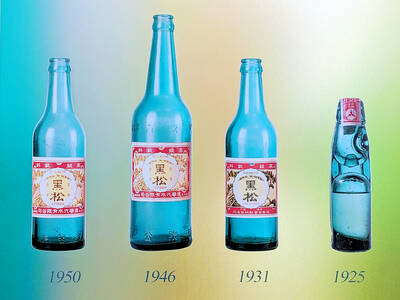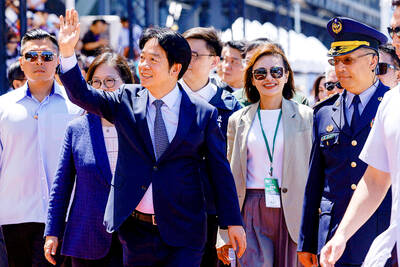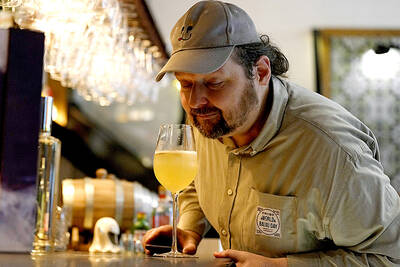The design of Futurism, an exhibit of Futurist movement sculpture, painting, furniture, clothing and writings, purports to demonstrate how contemporary the movement was by focusing on its obsession with youth, speed, and technology, but glosses over its violent, anti-environment, anti-feminist and fascist elements. Consequently, the show, installed in the bowels of the recently un-renamed Chiang Kai-shek Memorial Hall to mark the centenary of the Futurist movement’s founding, fails to explain the ideological underpinnings that facilitated its rise.
Filippo Tommaso Marinetti proclaimed the arrival of the art movement in his Futurist Manifesto, a screed published in Le Figaro in 1909. “We want to demolish museums and libraries, fight morality, feminism and all opportunist and utilitarian cowardice ... We want to exalt movements of aggression, feverish sleeplessness, the double march, the perilous leap, the slap and the blow with the fist.” The original article, along with many other futurist writings, is displayed at the exhibition, but it would require a telescope to read as it is fixed under glass that is displayed about 1.5m behind a barrier. There is no accompanying Chinese- or English-language translation.
And yet, although the ideological aspects that gave birth to the movement are barely touched upon, the chronological and artist-centered structure of the exhibit is notable because it illustrates the manner in which the artists’ pictorial experiments thematically investigate the development of some of the era’s technologies — particularly the speed of vehicles — and social developments, such as the growth of cities.
“[T]he world has been enriched by a new beauty: the beauty of speed,” Marinetti wrote in his Manifesto. “We want to sing the man at the wheel, the ideal axis of which crosses the earth, itself hurled along its orbit.”
Giacomo Balla explores this dispensation in Velocita + Luci. The shapes painted on the canvas are fractured into parallel and circular strokes of browns reminiscent of a car’s outline. Beams of white emanate from these forms and express the velocity of automobiles.
Roberto M. Baldessari also investigates the motion of vehicles in Treno alla Stazione di Lugo. The focal point of the painting is a woman dressed in red who is approaching a steaming locomotive that is in the process of entering a station. Employing a visual language similar to the Cubists, the lines in the immediate foreground are fragmented in a way to offer multiple perspectives, while the background trails off into a blur. It deftly replicates the perception of looking through the window of a train moving at full speed.
The city, with its industrial buildings and frenetic street activity, was a favorite subject of the Futurists.
Ivo Pannaggi examines the relationship between man and architecture in Il Lavoro. The painting shows a man standing triumphantly on the upper reaches of a partially finished building and peering down at two fellow workers below. Verossi’s (Albino Siviero) In Volo su Ponte Pietra offers us a look at what Pannaggi’s human figure might see. The viewer is looking at a canal many stories below, the straight lines of the waterway and bridge that spans it suggest feats of engineering perfection and man’s control over nature.
Whereas the earlier canvases portray a terrestrial perspective, Tullio Crali transports the viewer up into the sky Incuneandosi Nell’abitato. Here we see the city from an airplane cockpit as it nosedives towards the ground.
Though concerned with depicting the latest technological advancements and their effects on human perceptions, the Futurists were also interested in putting their stamp on everyday items, as is demonstrated by the clothing, sculpture and furniture that make up the middle part of the exhibit.
These objects along with the themes of the paintings demonstrate the relevance of the Futurists to our own society. And yet, it’s difficult to imagine that the organizers weren’t aware of the message they were sending when they decided to hold an exhibit of artists who celebrated war and fascism — without focusing on the more politically sensitive aspects of the movement — within the walls of a monument built to memorialize a right-wing dictator.

The unexpected collapse of the recall campaigns is being viewed through many lenses, most of them skewed and self-absorbed. The international media unsurprisingly focuses on what they perceive as the message that Taiwanese voters were sending in the failure of the mass recall, especially to China, the US and to friendly Western nations. This made some sense prior to early last month. One of the main arguments used by recall campaigners for recalling Chinese Nationalist Party (KMT) lawmakers was that they were too pro-China, and by extension not to be trusted with defending the nation. Also by extension, that argument could be

Aug. 4 to Aug. 10 When Coca-Cola finally pushed its way into Taiwan’s market in 1968, it allegedly vowed to wipe out its major domestic rival Hey Song within five years. But Hey Song, which began as a manual operation in a family cow shed in 1925, had proven its resilience, surviving numerous setbacks — including the loss of autonomy and nearly all its assets due to the Japanese colonial government’s wartime economic policy. By the 1960s, Hey Song had risen to the top of Taiwan’s beverage industry. This success was driven not only by president Chang Wen-chi’s

Last week, on the heels of the recall election that turned out so badly for Taiwan, came the news that US President Donald Trump had blocked the transit of President William Lai (賴清德) through the US on his way to Latin America. A few days later the international media reported that in June a scheduled visit by Minister of National Defense Wellington Koo (顧立雄) for high level meetings was canceled by the US after China’s President Xi Jinping (習近平) asked Trump to curb US engagement with Taiwan during a June phone call. The cancellation of Lai’s transit was a gaudy

The centuries-old fiery Chinese spirit baijiu (白酒), long associated with business dinners, is being reshaped to appeal to younger generations as its makers adapt to changing times. Mostly distilled from sorghum, the clear but pungent liquor contains as much as 60 percent alcohol. It’s the usual choice for toasts of gan bei (乾杯), the Chinese expression for bottoms up, and raucous drinking games. “If you like to drink spirits and you’ve never had baijiu, it’s kind of like eating noodles but you’ve never had spaghetti,” said Jim Boyce, a Canadian writer and wine expert who founded World Baijiu Day a decade